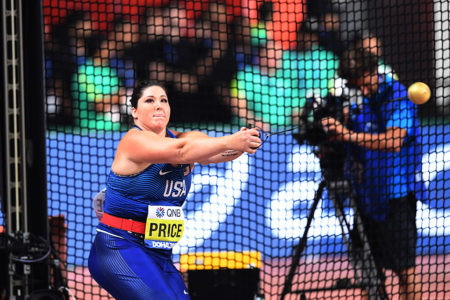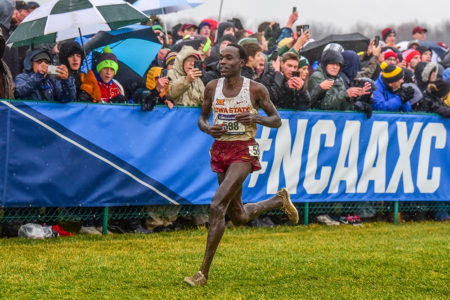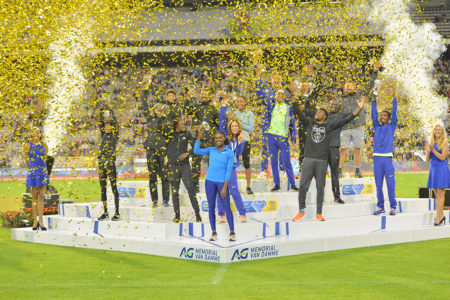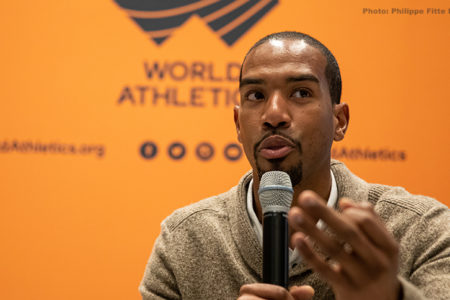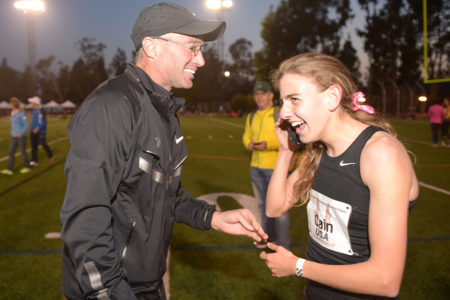
WALKING OUT OF THE World Championships hammer circle after the last throw of the final, DeAnna Price burst into tears and hugged silver medalist Joanna Fiodorow as the pair jumped up and down in an ecstatic embrace. The waterworks, which continued along with an irrepressible smile through the 26-year-old American’s victory lap in Khalifa Stadium, marked the breaking of a dam. Price had made herself not just the first U.S. women hammer gold medalist, but also the first to place higher than 6th in World or Olympic competition.
The 2-time NCAA champion for Southern Illinois, coached by Saluki throws mentor J.C. Lambert—whom she married in October of ’18—has improved her PR in each season save one (’14) since she first picked up the ball on a wire as a Missouri high school soph.
In the chat with T&FN that follows, the American Record holder asserts her fervent belief that, given good health, even longer blasts lie ahead as the Tokyo Olympics roll up on us. We caught up with her by phone at home in Carbondale on an early cold snap November afternoon.
T&FN: How does the almost-Thanksgiving season find you?
Price: I’m good, I’m good. I’m just getting things settling. I had practice early this morning and then took my dogs for a walk, so it’s been good.
T&FN: You took your dogs for a walk. Did that include the Bernese puppy we heard you got after winning the World title?
Price: Yes, I have a mini Australian Shepherd named Maverick and then I have little baby Bella but her nickname is Baby Doha.
T&FN: You hit all the high notes this season—an AR at Nationals and then gold in Doha. Now that you’ve had a few weeks to reflect, what are your thoughts on the year?
Price: It’s been great but the big one, you know, is in 8 months. So we’re getting ready. We didn’t really have time to really sit down and celebrate. A lot of people are asking us to come out and see them but I had only about 2 weeks that I was really able to do that because, you know, we have to get back to the grind and get ready to get training.
T&FN: You were one of two U.S. gold medalist throwers at this Worlds coached by a spouse, along with Joe Kovacs. How long has J.C. been your coach?
Price: He and [former Saluki, now Mississippi, throws coach] John Smith coached me my sophomore year and then it became J.C. at the end of 2015.
T&FN: That was an important time in your development. First of two NCAA titles in 2015, made the World Champs team and then the Rio Olympics the next year.
Price: So the first year that I was with J.C. we did stick with Coach John’s program and then after that we kind of both realized that I have to be more athletic and really start moving the ball a lot faster and being quicker with myself. So we ended up dropping 45lb [20kg] and keeping the strength as well. So we were just making sure that we’re trying to be explosive, trying to be fast, strong, and you know it paid off going into my 2018 season. The 2017 season wasn’t the best. It was good, I still threw a PR, I was still doing well but there were a lot of steps that I feel like I was missing. And then J.C. and I both kind of realized that if we wanted to be one of the best throwers out there we had to make certain changes. And even this year we were making changes again; he had me trying to lose weight this year as well, just trying to live a healthier lifestyle all the way around.
T&FN: Are there challenges to having your husband as your coach?
Price: Oh, all the time. You just can’t take it personally. I suppose you want to take it personal but he’s looking after the best. ’Cause when it was Coach John, I could go home and do whatever I wanted. Now when I go home he’s like, “Hey, do you think you should really eat that, do you think that’s going to be the best for you on our goals?” He’s really big on holding yourself accountable for your actions. And, yeah, I love it.
T&FN: How did you discover the hammer? I read that somebody in your hometown introduced you to the event?
Price: Yeah. His name is Gary Cooper. So the first time that I picked up the hammer was my sophomore year [of high school]. He kept asking me to come over and I felt, “I feel really uncomfortable coming over to someone else’s house.” Like, “I don’t really know you.” I knew his daughter pretty well. He was really nice but I thought, “Why do I want to train for the hammer when high school is only shot and discus?” I didn’t really understand that. So he talked to my parents and altogether I had about 3 months of training from my sophomore year to my senior year ’cause I did 4 sports: softball, basketball, volleyball and track. So I never really got to focus on the hammer long enough but within that 3-month training period I was able to throw it 180ft.
T&FN: Did it feel from the start like a natural event for you?
Price: Yeah, it did. Because of softball. Batting was one of the things I was really good at so I was like, “Oh, this is kind of like batting. You just hold position and swing.”
T&FN: Except it has that much longer lead-in with 4 turns.
Price: Exactly.
T&FN: Is there a certain point in the execution of the turns that you can usually tell if it’s going to be a long throw?
Price: For me it’s usually entry, so if I can feel from the entry how it’s going to be I can usually tell from there how that throw is going to go. So for me it’s all the money on the entry. It’s that “being connected” feeling.

T&FN: You have said you experienced what initially was an inexplicable drop in performance early in the 2019 season. Given the year’s unusual timing, that you would have been aiming to be at your best in Doha in the fall, it wasn’t glaringly apparent to observers from afar. You threw 254-0 (77.43) in late June so all seemed kind of OK from the outside. What was up?
Price: So I was throwing 77m [in training] in early-early March, which is fantastic. So I was sitting there on my couch saying, “I’m gonna throw 80 this year.” Then I don’t know exactly what happened. My lifting was great but, you know, there’s those little injuries that just sometimes like to pop up. And it wasn’t something like, “Ouch!” It was just something that for some reason I wasn’t really able to turn and all my throws dropped about 40–45ft. And I was having trouble throwing even my 4K [standard weight hammer] over 70 meters. It was weird and I remember sitting there—and me and J.C., we had just got married and we’re sitting there like, “Well, are we pregnant? What’s going on here?” You start questioning everything, you know. “Is it my diet?” and you’re trying to figure out all these different things. I was like, “Something is not firing correctly and I can’t turn. What is the issue?”
T&FN: What were the symptoms? Was your back sore?
Price: It was my hip and it just refused to turn, and I’d never had that happen in my life. It had started really hurting in the beginning of April and then when May came around I actually started having pains. J.C. and I were just scratching our heads trying to figure it out. I remember crying all the time; it messes with you mentally. Luckily, J.C. has a really good friend named Cory Martin, the throws coach at Indiana, and Cory said, “I know this [manual medicine and rehab specialist], his name is Brian Murer, you should really go and see him.”
I was like, “OK.” We were going to throw at Indiana anyway that week so I was like, “I’ll just go a couple of days early and see what this guy’s about.” And he used to be a hammer thrower, as well [3-time NCAA scorer for SMU in the early ’90s]. Such a sweet guy. The first time he worked on me, it was about 2 hours he worked on me. Just working on reactivating certain muscles. He said that basically everything kind of got locked down. It just blew my mind, it was crazy because the first time he worked on me, that weekend I threw 75.74 [248-6]. I thought, “Wow! I haven’t thrown that far in a long time.” And then the second time that he worked on me I threw 77.43 [254-0]. I see him now about once every 2 weeks. He said my upper body was turning left while my lower body was turning to the right. My body was just for some reason being funky.
T&FN: So some muscles just weren’t firing.
Price: Yes, and then you’re compensating. He did a lot of dry needling to reactivate a lot of the muscles and we do a lot of different stretches and stuff now to keep those muscles fully operating.
T&FN: In retrospect, you traveled a long way in May to the IWC meets in Osaka and Nanjing to throw—by your standards of the previous year—unspectacularly. Now we know you were working through physical problems. How did you look at that competition trip?
Price: It was one of those things where they had already bought my tickets and it was kind of one of those things where [laughs] you don’t want to piss ’em off, you don’t want to tick them off. It was one of those things where I didn’t really want to go but you want to keep being invited to those meets. You don’t want to be one of those athletes that they spend all this money on and don’t go. So with some hesitation we said, “We’ve just gotta suck it up. It’s two meets, let’s do it and get it done.” And the first meet I was definitely feeling it because that’s a long flight. I think I went 72-something.
T&FN: 72.92 [239-3].
Price: I remember J.C. calling me and saying, “That sucks.” Well, thank you, I appreciate that. But we both knew it wasn’t going to be great. But he’s awesome because he’s always giving me checks and reality, I guess you could say. But when I went to China that one was a lot better. I finally got one good throw off. I think it was 74…
T&FN: 74.21 [243-5].
Price: 74.21, which at that time was my second-farthest throw internationally. I said, “OK, can’t be too upset about that,” because, honestly, this year what we really wanted to focus on was being able to throw competitively at an international level. You know, I can throw far in the United States but it doesn’t mean anything if you can’t do it internationally. So that was OK. After that we got back home and really, really grinded it out. After that I went to Brian’s, if I had to guess, once every week just to try to get back in line. He’s such an amazing guy. Love him to death and his family is so supportive.
T&FN: Then the next time you competed after the Asian meets, in Bloomington near the end of June, you threw 77.43 (254-0), the No. 3 mark of your career to that point. Back on track 3 weeks before Nationals. Now we’re talking.
Price: Yeah and I had a foul out the left side that was really far. It was like, “Man, we are homing in, it’s really close.” And when we went to USAs I got Brian up there to come with me and he’s going to come with me to Eugene [the Olympic Trials] next year. And I just remember sitting there in Des Moines and when I woke up for some reason my hip locked up because that week—I’ve never moved faster in my life. My hip locked up and I was, “Oh my God. Don’t freak out, don’t freak out.” I had to compete the next day and I thought, “What am I going to do?” I couldn’t be in the sit position and I was like, “Oh my God, nightmare.” I went to Brian and he was dry needling me and he said, “Don’t worry about it. Do not worry, you’ll be fine. We’ll take care of you.”
I went out in the morning and it was still really tight and I remember sitting there and there was that rain delay.
T&FN: So you welcomed the rain delay? It gave you more time to get the hip unlocked?
Price: Oh, yeah. I was praying for that rain delay. Because within that hour that we had to wait my hip started loosening up again. So I was like, “Yes!” I was really excited, I thought, “Awesome, I am really happy about this. Great!” Next thing you know I was able to actually throw and I was feeling better. It wasn’t exactly what we wanted but it went pretty good.’
T&FN: Pretty good. You broke the American Record on your last throw but you also controlled the competition from the beginning. It’s not like you ever fell into any scary back-against-the-wall moment with foul trouble or anything. You got a world leader in round 2 and rolled from there.
Price: Yeah, we threw really well. I’m really happy about it. I definitely have to credit that to J.C. and Brian Murer getting me through that. And then it was about a month and a half of training with the cage closed to kind of get used to that. You know, in Doha it was a lot closed.
T&FN: So you tried to simulate World Championships conditions in practice. What did you do specifically?
Price: Oh, yes, every weekend. So Friday was “qualifying” and Saturday was “finals.” What we did was first 3 throws hit them over 73m, and then on “finals” attack within the first 3. And we got that down to a T. The first 2 weeks it was kind of shaky. My first throw would be like a 72, maybe a 71 and then I’d throw a 72 and my third would be like a 73. J.C. said, “You have to make sure your first one’s a one-and-done.” So by two weeks I was throwing consistently 73m on my first throw.
T&FN: Then the next day you’d do “the final.”
Price: Yup, I’d get in there and “It’s final time, time to gear up.”
T&FN: What do you need to do to throw 80m [262-5]? What might happen compared to your AR throw that could get you that little bit farther?
Price: As long as I stay healthy 80m is in my future. It is. It was there this year, 80 was right there. Our goal this year is to make it to the Olympic Trials and it’s all about that meet, of course, and then be able to repeat it a month later. All I know is that if I’ve got the strength, the crazy strength of this year, my technique was way better last year. So if we can implement the two, you’re going to see some crazy stuff happen. I won’t state specific numbers…
T&FN: Are you going to throw the weight indoors this year?
Price: Every year we say we’re not going to but usually I throw it once or twice. A lot of times I do it to throw with our team here at Southern Illinois, to kind of show them, “I haven’t thrown this [implement] in three weeks, you should be able to beat me.” That mentality, get them to see the bigger picture kind of thing.
T&FN: So you do it almost more for the Saluki throwers’ benefit?
Price: Yeah because for me in college I had Gwen [Berry] and Jeneva [Stevens] here. I’d watch them throw and think, “That’s amazing.” You were never No. 1 because they were always there competing with you. So it’s one of those things where you’re like, “Oh, OK, let’s do this.”
T&FN: How complementary is the weight to the hammer at this stage in your development?
Price: It’s just one of those things that it keeps you in shape a little bit. I try not to throw it too much because long wire/short wire, it is a big difference. You really want to keep that length and staying with the hammer throughout. Because with the weight you try to rush it a little bit more. So just try to stay long and work with the ball. If you stay with that you’ll do good.
T&FN: You competed in four sports in high school. Which was your favorite besides the hammer?
Price: Oh, softball. I love softball. I actually held the home run record for Missouri, I had a batting average of, I believe it was .525. I love softball, but shoot, they took that out of the Olympics too.
T&FN: Isn’t it coming back in?
Price: It will be in for this Olympics but they just announced that it’s going to be out for 2024 [a Paris 2024 organizers’ decision awaiting approval by the IOC].
T&FN: Here today, gone tomorrow.
Price: I know. I thought, “You just brought it back!”
T&FN: How, then, did you wind up competing in college track and not softball?
Price: One, because they did take softball out of the Olympics for 2012 through ’16. I was just graduating from Troy Buchanan in 2011 and I had played softball ever since I was 5 years old. It was something I just breathed every single day. But hammer throwing was something new, a different opportunity, something that I felt I had a potential to do something great in. And on top of it the university at Carbondale had such a great throws program. They were No. 1 in the country, they had a fantastic Accounting program. I remember thinking, “This feels like home to me here.” And that’s one of the reasons that I haven’t left. I’ve been here since 2011 and it’s 2019. I ain’t leaving any time soon.
T&FN: What do you and J.C. like to do in your free time that’s not hammer throw related?
Price: We love, of course, walking our dogs. But what I really like doing is artwork. I also sing a little. I like to do those types of things. I go around to schools and talk to kids about body imaging and that kind of stuff because I’ve been on both sides of that spectrum. I’ve been really, really skinny and I’ve been really, really big. I try to express to them about just living a healthy lifestyle. You know I weigh 230lb [105kg] but I’m living the best life that I can be for my sport and what I need to do with my life.
T&FN: I read that your Mom had the 800m record for your high school and that when somebody broke it you wanted to get out there and reclaim it for your family. True?
Price: Oh, yeah. At Troy Buchanan High my Mom held the 800m record and it got broken a couple years before I came to school. I remember saying, “I want to go out for track.” My Mom said, “How cool would it be if we both have had the high school record?” I said, “That sounds awesome!” I remember going and I was practicing and running, and my brother was a senior and he had this really good friend named Erin Cooper, who was [Coach] Gary Cooper’s daughter. She was like, “You’re gonna come with me and we’re gonna be throwers.” I was like, “Wait, isn’t that for the unathletic people?” I didn’t really know and usually the coach would pick the biggest people and, “Go over there.” At the time I only weighed like 140lb [c65kg] and I was like, “OK, let’s give it a try.” Erin was really small too, Erin was like only 120 [55kg] and I was like, “Wait, you throw?!”
We went over there and I had blasts. The first time I picked up the discus it went about 68ft [21m], so a wind and a smack, and they were like, “Oh! Alright.” I was out there throwing for about 2 weeks. My Mom, we talked again, she said, “Wouldn’t it be really cool if you had my record?” I thought, I’m gonna go back to the 800, why not? My head coach was like, “No. You’re too good a thrower.” I said, “Mmmm, OK,” and then I went to State all four years [laughs].
T&FN: Kismet, sounds like, that your friend Erin dragged you over to the throws.
Price: Exactly. Just that small moment. If she never had done that, I probably wouldn’t have thrown, I probably would have run the 800, I probably would have never got a scholarship to Southern Illinois, I would have never met my husband. It’s just a chain reaction of things out of one small moment in your life. And that’s what’s kind of crazy.
